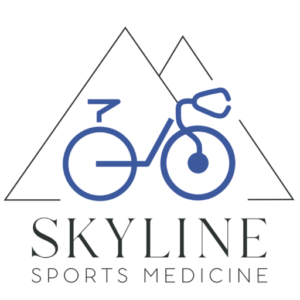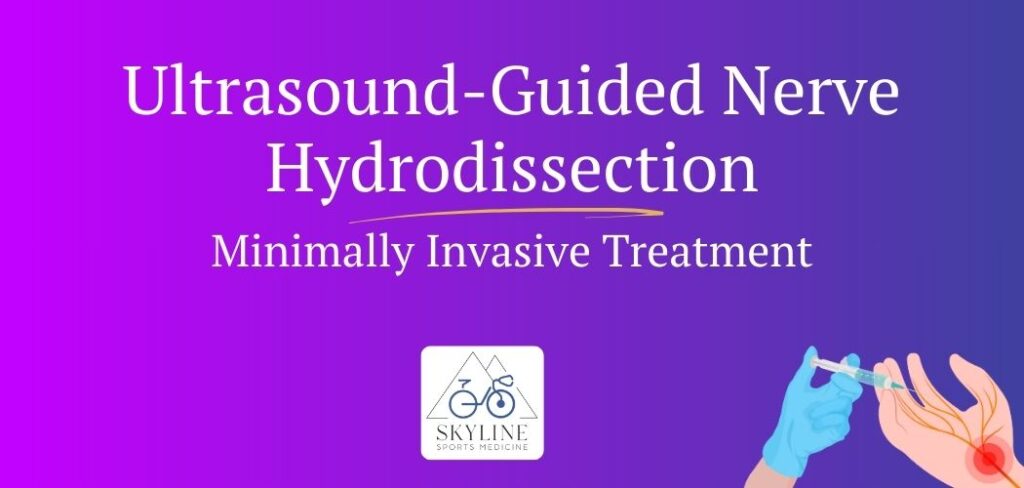What is Nerve Hydrodissection?
Nerve hydrodissection is a procedure used to treat trapped nerves. It involves injecting an anesthetic or saline solution to gently separate the nerve from the tissue or structures around it. It’s done with the help of ultrasound to ensure the process is safe and accurate.
According to one of the studies, about 2.4% of people globally suffer from some form of neuropathy. It mainly occurs due to the compression of nerves, which blocks nerve signals and causes ache in the respective body parts.
Nerve entrapment can happen due to various reasons, including:
- Prolonged poor posture
- Repetitive limb movement
- Pressure on a nerve after an injury or surgery
Nerve hydrodissection may have a daunting name. But it does not involve any dissection or cutting. This treatment relieves nerve entrapment (also known as compression neuropathy or entrapment neuropathy).
- Perineural hydrodissection
- Percutaneous neuroplasty
- Hydro-release
- Ultrasound-guided nerve release
- Fluid-based nerve release
As complicated as it might sound, there is no need to worry if you think you might need this procedure. Dr. Svetlana Dani, MD is an expert in nerve hydrodissection with a high success rate. If you live in California, you can easily book an appointment and visit her office in Los Gatos, San Jose.
Book a Consultation with Dr. Svetlana Dani, MD
The Best Sports Medicine Physician in San Jose
Dr. Dani can help you get back to peak performance.
If you:
- Are Suffering From a Sports Injury
- Need Assessment and Advice on your performance
- Want Cutting-Edge Treatment & Rehabilitation
We Can Help
The Procedure
Nerve dissection is a brief, yet an effective procedure that involves very few steps mentioned below.
1. Cleaning and anesthesia
First of all, the affected area is externally cleaned. Then, a local numbing agent is applied to numb the pain area before injection.
2. Ultrasound Guidance
Your doctor will use an ultrasound to find the exact spot and guide the needle around the nerve and nearby tissues. This assists in the right insertion of the injection needle.
3. Needle Insertion
A small needle is penetrated into the target point surrounding the nerve. The entire injection process is done using ultrasound to avoid damaging the soft tissues and ligaments.
4. Fluid Injection
Your doctor will then inject a saline or a combination of saline + 5% dextrose fluid in the target location. This fluid helps to separate the trapped nerve from the tissues that are pressing on it.
5. Careful Monitoring
At the end, the needle pricked area is cleaned and a small bandage is applied. You will be briefly monitored to make sure that there is no immediate side effect.
The number of sessions depends on the severity of nerve entrapment. In some cases, only a single treatment is enough. However, some patients may need additional sessions.
Is it Painful?
Nerve hydrodissection is less likely to be painful since a local anesthetic is used to numb the affected area before the injection. As the effect of anesthesia subsides, you may feel a slight soreness at the injection point. This mild pain can be managed with over-the-counter painkillers like ibuprofen or acetaminophen.
Am I a good candidate?
You are likely a good candidate if:
- You’ve tried medications and exercises but still have symptoms.
- You prefer non-surgical options to manage your pain.
- You want a simple, minimally invasive procedure that leaves little to no scars.

Nerve Hydrodissection with Dr. Dani
Dr. Dani specializes in non-invasive techniques and wants everyone to live a normal healthy life. Whether you are:
- Having difficulty juggling everyday activities
- You’re an athlete having nerve compression issues
Or if you want a quick and proven treatment method, make sure to visit Dr. Dani in San Jose, Bay Area. She makes sure that you’re well-attended from the consultation day to the procedure and then follow-up. Here’s how you’ll be assisted:
- During the first visit, Dr. Dani will provide a thorough consultation. She will review your medical history and ask questions about your symptoms.
- Later, she will evaluate your condition and ask questions like if you’ve tried any other treatment before.
- You are also encouraged to ask her any questions there you’ve in mind regarding nerve hydrodissection.
- She will make sure that you’re completely satisfied before opting for the treatment and guide you regarding your treatment plan.
- If you’re eligible for hydrodissection, your procedure will be scheduled for another day.
After getting done with the procedure, you can also visit again for a follow-up. She would be happy to help you and answer any concerns that you might have.
How Much Does it Cost?
The nerve hydrodissection procedure is covered by insurance. Dr. Dani and her staff will go through the paperwork. They will make sure that you are covered by insurance and the paperwork is hassle-free.
However, if you are willing to pay from your pocket, you can discuss it in the office. You’ll be guided regarding the cost.
It is important to have financial clarity before going for any treatment. So, you must discuss whatever question comes to your mind and Dr. Dani’s staff will make sure to guide everything beforehand.

What Does it Treat?
Nerve hydrodissection can help with nerve entrapment issues in the wrist, elbow, shoulder, and knee. However, it may not be suitable for severe nerve damage, advanced diabetes, blood disorders, or open wounds.
The severe cases may need additional therapy for complete cure. You’ll have to visit your doctor for the accurate assessment of your condition and getting a tailored treatment plan as per your need. Dr. Dani uses ultrasound-guided injections to treat the following conditions with hydrodissection.
Wrist – Median Nerve (Carpal Tunnel Syndrome)
Carpal tunnel syndrome, also called median nerve compression, affects 1-5 out of every 100 people at some point in their lives. The carpal tunnel is a narrow passageway between the ligaments and bones on the inside of the wrist.
In carpal tunnel syndrome, the median nerve in the wrist is entrapped by the surrounding structures. This condition irritates the tendons in wrists and occurs due to strain on hand or overuse and repeated hand movements, such as:
- Extensive typing
- Regular push-ups
It specifically causes pain, tingling, and numbness in the hand area, including:
- Wrists
- Palms
- Thumb
- Middle finger
- Index finger
- Ring finger
Hydrodissection helps the median nerve move more easily in the palms and reduces discomfort.
Elbow – Ulnar Nerve (Cubital Tunnel Syndrome)
In cubital tunnel syndrome (also known as ulnar nerve entrapment), the ulnar nerve gets pinched as it travels through the elbow. This can cause weakness in the hand, along with pain and tingling in areas supplied by the ulnar nerve, such as:
- Little finger
- Ring finger
You may feel inconvenience in hand and elbow movements, particularly due to prolonged:
- Gripping
- Pinching
- Elbow bends
- Pulling
- Lifting
Nerve hydrodissection can reduce pressure and friction on the ulnar nerve, easing symptoms. For example, American athlete Ryan Crouser used this treatment twice after injuring his ulnar nerve.
Knee, Foot & Ankle – Fibular (Peroneal) Nerve
The fibular nerve, also known as the peroneal nerve, runs along the knee and lower leg, wrapping around the fibula bone. It helps with movement in the lower body and provides sensation to the lower part of the leg, such as:
- Foot
- Toes
- Lower leg
Peroneal nerve damage leads to pain, numbness, and difficulty lifting the foot while walking (known as foot drop). This issue occurs due to:
- Knee injury
- Strain due to casts or braces
- Sitting cross-legged
- Improper positioning while sleeping
Hydrodissection relieves the pressure from fibular nerve in the knee, ankle, and foot. It also treats nerve irritation related to the Achilles tendon. The treatment ultimately improves the motor functions in the foot and lower leg area. And you will have greater control on your foot after this treatment.
Scar tissue pain
Under normal conditions, nerves glide smoothly around surrounding structures. But this gliding movement can be affected, and tissues can become scarred due to various reasons, such as:
- Injury
- Trauma
- Surgery
Fascia refers to the protective tissue layer beneath the skin, bones, and muscles. Scar tissues cause fascial layers to tighten and stick with the adjacent nerves or muscles. This nerve entrapment due to scar tissues, in turn, causes multiple issues as given below:
- It blocks blood flow.
- It reduces the nutrition supply of nerves.
- It induces pain, inflammation, and friction.
During the hydrodissection of scar tissues, fluid is injected into the scar tissues. The fluid relieves the adhesions formed in fascial layers around scar tissues. This ultimately improves the gliding movement and alleviates scar tissue pain. This procedure is also known as facial hydrodissection.
The Recovery

Dr. Dani prohibits strenuous activities for at least 2-5 days after the procedure because a little soreness might be there. In some cases, a brace may also be needed but it totally depends on the body part that underwent the procedure.
Patient is discharged right away and he/she can usually continue mild physical activities the very same day. However, it is advised to take rest for a day and avoid demanding physical activities. Such as heavy weight lifting or exercises that could harm the treated area.
Side Effects
Nerve Hydrodissection is a non-surgical and minimally invasive procedure. Therefore, any major complications are less likely to occur. In addition, with the recent introduction of ultrasound guidance, it has become safer than ever. However, some patients still face temporary hydrodissection side effects.
Most of the temporary yet common side effects include:
- Pain or soreness at injection point
- Swelling or redness around the injection area
Few of the side effects that are extremely rare are:
- Infection
- Allergic reaction
- Weakness in treated area
It’s important to tell your doctor about your allergies and medical history before any diagnosis or treatment. This helps ensure you get advice and a treatment plan tailored to your needs. Also, make sure to inform your doctor in case of any unusual after-effects.
Recovery Time
Nerve hydrodissection recovery time depends on the individual’s health and severity of the entrapment. After the procedure, most patients quickly feel a big drop in pain and numbness they had before. Usually, patients can go back to their normal activities the day after the procedure.
Here’s what you can expect after getting the treatment:
Day 1-2
- You might experience pain around the first two days. And pain killers usage usually subsides the pain.
- Braces are often recommended depending on the treated body part. It restricts the movement, which speeds up the healing.
- Though strict bed rest is not necessary. But it’s better to take a one-day leave from work and avoid any intense activities.
Day 3-5
- You may still experience a little soreness. Continue taking over-the-counter painkillers when needed.
- Avoid any repetitive movements or strenuous activity that puts strain on the treated body part.
Day 6-14
- Pain usually subsides but you should still avoid contact sports as a precautionary measure.
- Continue following the instructions provided by your doctor to facilitate complete recovery.
Schedule your appointment today with Dr. Dani and have the tailored treatment plan according to your condition!



